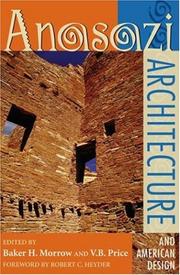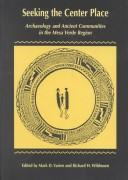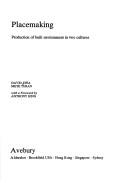| Listing 1 - 10 of 10 |
Sort by
|
Book
ISBN: 1555907628 Year: 1988 Publisher: Monticello (Ill.): Vance bibliographies
Abstract | Keywords | Export | Availability | Bookmark
 Loading...
Loading...Choose an application
- Reference Manager
- EndNote
- RefWorks (Direct export to RefWorks)
Pueblo architecture --- Pueblos --- Bibliography
Book
ISBN: 0792006712 Year: 1990 Publisher: Monticello (Ill.): Vance bibliographies
Abstract | Keywords | Export | Availability | Bookmark
 Loading...
Loading...Choose an application
- Reference Manager
- EndNote
- RefWorks (Direct export to RefWorks)
Kivas --- Pueblo architecture --- Bibliography

ISBN: 0826317790 Year: 1997 Publisher: Albuquerque University of New Mexico Press
Abstract | Keywords | Export | Availability | Bookmark
 Loading...
Loading...Choose an application
- Reference Manager
- EndNote
- RefWorks (Direct export to RefWorks)
Book
Year: 1990 Publisher: Santa Fe, N.M. : Division of History, Southwest Cultural Resources Center, Southwest Region, National Park Service, Dept. of the Interior,
Abstract | Keywords | Export | Availability | Bookmark
 Loading...
Loading...Choose an application
- Reference Manager
- EndNote
- RefWorks (Direct export to RefWorks)
Pueblo Indians --- Pueblo architecture --- Excavations (Archaeology) --- Antiquities. --- Conservation and restoration. --- Aztec Ruins National Monument (N.M.) --- New Mexico
Book
ISBN: 3770113713 Year: 1983 Publisher: Köln DuMont
Abstract | Keywords | Export | Availability | Bookmark
 Loading...
Loading...Choose an application
- Reference Manager
- EndNote
- RefWorks (Direct export to RefWorks)
Pueblo Indians --- -Indians of North America --- -Pueblo architecture --- 72.03 --- Architecture, Pueblo --- Architecture --- American aborigines --- American Indians --- First Nations (North America) --- Indians of North America --- Indians of the United States --- Indigenous peoples --- Native Americans --- North American Indians --- Bouwstijlen. Architectuurscholen. Architectuurstromingen. Bouwkunst: periodenen invloeden --- Culture --- Ethnology --- Pueblo architecture. --- 72.03 Bouwstijlen. Architectuurscholen. Architectuurstromingen. Bouwkunst: periodenen invloeden --- Ecological houses. --- Pueblo architecture
Book
ISBN: 0826359930 9780826359933 9780826359926 Year: 2018 Publisher: Albuquerque : Published in Association with School for Advanced Research Press,
Abstract | Keywords | Export | Availability | Bookmark
 Loading...
Loading...Choose an application
- Reference Manager
- EndNote
- RefWorks (Direct export to RefWorks)
"When, how, and why were the towns of Salmon and Aztec, in what is now the Four Corners region of the Southwest, established? What roles did these Middle San Juan sites play in the waning years of the Chaco world, known to archaeologists as the late Pueblo II and Pueblo III periods? This complex period has fascinated archaeologists for more than a century. Often overshadowed by the Pueblo centers at Chaco Canyon and Mesa Verde, the Middle San Juan is one of the most dynamic territories in the pre-Hispanic Southwest, interacting with Chaco Canyon and Mesa Verde as well the surrounding regions. This ancient Pueblo heartland was instrumental in tying together Chaco and Mesa Verde cultures to create a distinctive blend of old and new, local and nonlocal. The authors of this book attribute the development of Salmon and Aztec to migration and colonization by people from Chaco Canyon. Rather than fighting for control over the territory, Chaco migrants and local leaders worked together to build the great houses of Aztec and Salmon, while maintaining their identities and connections with their individual homelands. As a result of this collaboration, the Middle San Juan can now be seen as one of the ancient Puebloan heartlands that made important contributions to contemporary Pueblo society"-- "Often overshadowed by the Ancestral Pueblo centers at Chaco Canyon and Mesa Verde, the Middle San Juan is one of the most dynamic territories in the pre-Hispanic Southwest, interacting with Chaco Canyon and Mesa Verde as well the surrounding regions. This ancient Puebloan heartland was instrumental in tying together Chaco and Mesa Verde cultures to create a distinctive blend of old and new, local and nonlocal. The contributors to this book attribute the development of Salmon and Aztec to migration and colonization by people from Chaco Canyon. Rather than fighting for control over the territory, Chaco migrants and local leaders worked together to build the great houses of Aztec and Salmon while maintaining their identities and connections with their individual homelands. As a result of this collaboration, the Middle San Juan can be seen as one of the ancient Puebloan heartlands that made important contributions to contemporary Puebloan society. "--
Pueblo Indians --- Pueblo architecture. --- Excavations (Archaeology) --- Migrations. --- Material culture --- Antiquities --- Salmon Site (N.M.) --- Aztec Ruins National Monument (N.M.) --- San Juan River Valley (Colo.-Utah) --- Antiquities.

ISBN: 1607817888 9780874807356 0874807352 0874808545 9780874808544 9781607817888 0874807352 9780874808544 Year: 2002 Publisher: Salt Lake City : University of Utah Press,
Abstract | Keywords | Export | Availability | Bookmark
 Loading...
Loading...Choose an application
- Reference Manager
- EndNote
- RefWorks (Direct export to RefWorks)

ISBN: 1856284603 Year: 1993 Publisher: Aldershot, Hants, England ; Brookfield, Vt., USA : Avebury,
Abstract | Keywords | Export | Availability | Bookmark
 Loading...
Loading...Choose an application
- Reference Manager
- EndNote
- RefWorks (Direct export to RefWorks)
Cette étude comparative, un produit de plus d'une décennie de travail, se rapproche de l'architecture vernaculaire de la préhistoire et deux peuples très éloignés les uns d'une manière entièrement nouvelle. Les anciens Anasazi du sud-ouest américainet les "habitants roc", les habitants rupestres, de la Cappadoce en Turquie anatolienne ont trouvé des solutions aux problèmes de logement dans des environnements géologiquement identiques. Ce livre retrace le développement des colonies de peuplement dans ces deux endroits. "Placemaking" se situe dans le contexte de la forme de construction: la production de l'architecture et de règlement. Ceux-ci sont analysés en termes de forces sociales. On a beaucoup écrit sur les monuments, l'architecture sacrée (églises, kivas) et la signification symbolique de ces deux régions, et beaucoup moins sur les forces génératrices et les finalités de l'activité de construction ordinaire. Ce livre est une tentative de "rétablir l'équilibre", en s'appuyant également sur les résultats de cette étude de cas comparative à produire un cadre général pour l'interprétation.
Book
ISBN: 0670582093 Year: 1975 Publisher: New York Viking press
Abstract | Keywords | Export | Availability | Bookmark
 Loading...
Loading...Choose an application
- Reference Manager
- EndNote
- RefWorks (Direct export to RefWorks)
Pueblo Indians. --- Pueblo architecture. --- Pueblos. --- 72.031.8 --- 72.031.4 --- 72.031.2 --- 72.03 --- Noord-Amerika --- Verenigde Staten --- Architecture, Pueblo --- Pueblo Indians --- Architecture --- Ancestral Pueblo culture --- Indians of North America --- Pueblo architectuur --- Pueblo indianen (architectuur) --- Traditionele architectuur --- Vernaculaire architectuur --- Volksarchitectuur --- Primitieve architectuur --- Architectuur (geschiedenis) --- Architectuurgeschiedenis --- Dwellings --- Pueblo architecture --- Pueblos
Book
ISBN: 8323384932 9788323384939 8323331847 9788323331841 Year: 2011 Publisher: Krakow : Jagiellonian University. Press,
Abstract | Keywords | Export | Availability | Bookmark
 Loading...
Loading...Choose an application
- Reference Manager
- EndNote
- RefWorks (Direct export to RefWorks)
Thirteenth century A.D. was a time of many changes and reorganization in the ancient Pueblo world in the Mesa Verde region. Still unresolved are the causes of the migration of Pueblo people from the Mesa Verde region to the south and southeast in the end of the century. The theories most cited and most supported by scientific data include environmental changes, increasing conflict and violence, social changes, and the attraction of a new cult or ideologies from the south. However, it seems that none of these theories can fully explain the total depopulation of the region. One reason often cited for the depopulation of the area is increasing conflict and violence. Evidence of conflict is clearly visible archaeologically: sites located in places difficult to access; defensive buildings, and settlement layouts; human remains with evidence of a violent death; and rock art depicting violent interactions. During the thirteenth century A.D. many types of defensive architecture including towers, underground tunnels connecting structures in a settlement, loopholes, and massive stone walls that partly or fully enclosed villages were constructed in the central Mesa Verde region. These architectural changes were associated with population aggregation and relocation; during the thirteenth century, most people probably lived in large settlements situated such that they were difficult to access and easy to defend. In many villages, water sources were secured within the boundary of the settlement or were at least nearby. However, it is difficult to determine whether the defensive architecture and defensible locations were not enough of an obstacle against possible attackers as Pueblo Indians emigrated from the Mesa Verde region near the end of the thirteenth century A.D. into what are now northern and central Arizona and New Mexico.
Pueblo architecture --- Fortification --- Architecture and society --- Architecture --- Architecture and sociology --- Society and architecture --- Sociology and architecture --- Fortification, Primitive --- Forts --- Military engineering --- Siege warfare --- Architecture, Pueblo --- Pueblo Indians --- Social aspects --- Human factors --- Mesa Verde National Park (Colo.) --- Antiquities.
| Listing 1 - 10 of 10 |
Sort by
|

 Search
Search Feedback
Feedback About UniCat
About UniCat  Help
Help News
News